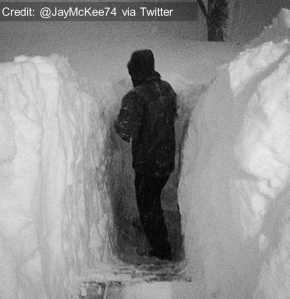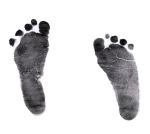More than a dozen people are dead, residents remain trapped in homes and roads are impassable. As Buffalo digs out from a record snowfall the focus moves to building collapses and flooding. Mother nature’s big dump stirs feelings of isolation and fear when you know you’ll be crushed by a mountain of snow when you open your door, but as seen below, some people overcame that by downing a few cold ones before clawing out.
Alcohol may have helped, but TV, social media and digital devices played an even bigger role to reduce fear and isolation. Six feet of snow is a record-setting height and during this event, the media set its bar just as high; they all complemented each other and connected the Buffalo community and the world in real time. This is just a glimpse into the future of story-telling, where consumers demand multiple sources of news from multiple forms of technology, even drones.
1. Local TV News Does It Best– Local stations covered the storm wall to wall and proved that TV is still the most powerful medium for big events. Why is this? TV stations dedicate hundreds of staffers and spread themselves across the scene when major stories hit. This provides a valuable public service and the metrics back this up. The Buffalo News reports that Channel 2, WGRZ was the ratings winner for the storm and viewership with stations beat a Buffalo Bills game, no small feat. Today’s TV news media is much more than reporters live in the field; journalists want want to share as many interesting human elements and public safety announcements possible. That’s why they dedicate personnel and resources to facilitate and coordinate the social media conversation.
2. Social Media Lit It Up -Posts ranged from warnings of a building collapse via the Erie County Sheriff’s Facebook page to multiple images of regular people trying to cope.
Lohud was one of many sites that chronicled stories of regular people digging out. Social Media posts appeared on TV stations, newspapers, other blogs and often went viral without media help.
3. Digital Technology Flies High –It’s strongly advised that news choppers avoid severe weather and news crews on the ground encountered limited mobility, so James Grimaldi programmed his drone to record video the storm with this dramatic story.
The blanket coverage from television news, aka “smotherage” combined with social media and digital story-telling made this communications effort one for the ages, just like this epic storm. I won’t predict the weather, but it’s safe to forecast that this is the future of news delivery and consumption. Local TV will always play a major role in our backyard and from now on, it will have an even bigger supporting cast of credible platforms with stories and images that bring the news even closer to us, in real time, which benefits everyone.
The opinions expressed in this blog are my own. My Twitter handle is Ronald Petrovich






